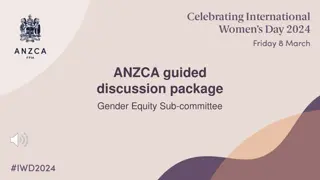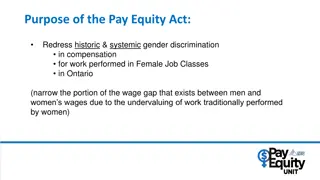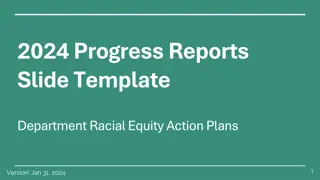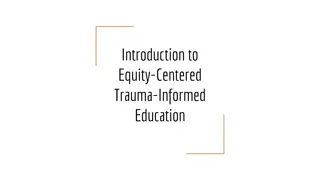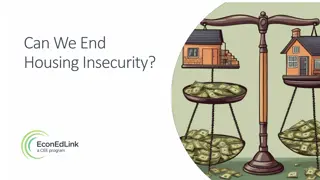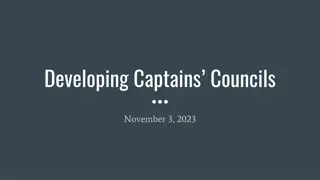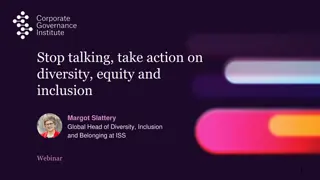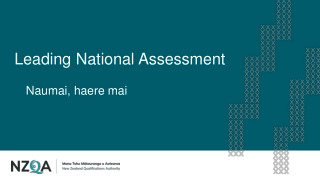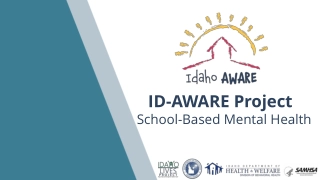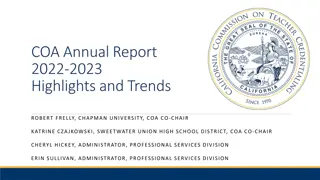Challenges in Implementing Evidence-Based Equity Programs
Equity and diversity initiatives in HPC and scientific computing face obstacles such as the "Yes, Minister" fallacy, ineffective mandatory trainings, pitfalls of gender equity committees, and survivorship bias. Dr. Emily Kahl from The University of Queensland highlights the need to avoid policy anti-patterns to ensure the success of equity programs.
Download Presentation
Please find below an Image/Link to download the presentation.
The content on the website is provided AS IS for your information and personal use only. It may not be sold, licensed, or shared on other websites without obtaining consent from the author. Download presentation by click this link. If you encounter any issues during the download, it is possible that the publisher has removed the file from their server.
Presentation Transcript
Evidence-based equity programs: Avoiding the "Yes, Minister" fallacy (and other policy anti- patterns) Dr Emily Kahl, The University of Queensland
Whither Equity and Diversity initiatives? Stereotyping and discrimination are bad HPC and scientific computing has a problem recruiting and retaining skilled professionals Extremely low representation of women in HPC Diversity issues aren't the only problem, but they're a problem It's not (only) about money: respect, feeling valued, getting a fair-go, being a nice place to work We need to live up to our principles as scientists! Frachtenberg & Kaner, SC '21, 18 1-14 (2021) 3
Anti-pattern 1: The "Yes, Minister" Fallacy "It's the old logical fallacy: all cats have four legs, my dog has four legs, therefore my dog is a cat. He's suffering from politician's logic..." "Something must be done, this is something, therefore we must do it." 4
Mandatory trainings: "this is something!" Tempting to create anti-bias training, especially as scientists Implicitly adopts the information deficit model of behavioural change Strong evidence most don't work: either no effect or negative effect on a firm's diversity Negative framing can activate biases, often disempowering and patronising Source: Dobbin F, Kalev A. Why Diversity Programs Fail. Harvard business review. 2016;94(7/8):52. 5
Anti-pattern 2: doomed committees Good: We don't want to have only old dudes on the gender equity committee Bad: The committee only has staff from under-represented minorities on board Worse: The committee has no real ability to change things, so makes no real progress Worst: Membership is not recognised come promotion time, so the members are worse off than if we'd done nothing 6
Anti-pattern 3: survivorship bias Try to talk to people from under-represented groups who left the field, not just those who managed to stay Source: M. Grandjean, McGeddon, C. Moll, CC BY-SA 4.0, https://commons.wikimedia.org/w/index.php?curid=1020 17718 7
Okay, so now what? Set values and uphold them Be clear about what you want to achieve and how you'll determine success Stop and think: "will this thing achieve what I want it to achieve?" Must be supported at all levels, top to bottom Take a positive framing for messaging Empower employees and managers to make changes Positive exposure to minority groups is important Still big gains to be had in material equity, too 8
Some useful starting points: Paluck & Green, Prejudice Reduction: What Works? A Review and Assessment of Research and Practice, Annu. Rev. Psychol. 2009. 60:339 67. Paluck et al, Prejudice Reduction: Progress and Challenges, Annual review of psychology. 2021;72(1):533 60. Cox, Developing scientifically validated bias and diversity trainings that work: empowering agents of change to reduce bias, create inclusion, and promote equity, Management decision. 2023;61(4):1038 61. Dobbin & Kalev, Getting to diversity: What works and what doesn t, Harvard University Press. 2022. Hernandez, Discipline-Based Diversity Research in Chemistry, Accounts of Chemical Research. 2023. 9












